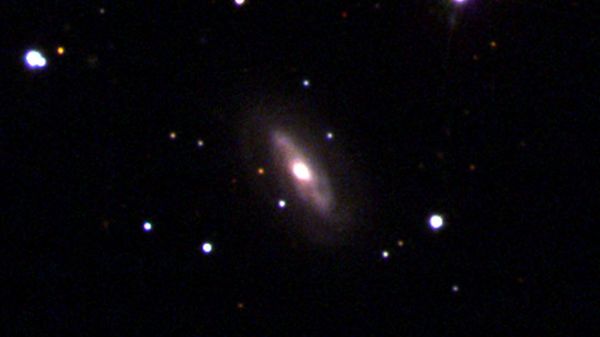A supermassive black hole is speeding through space, and astronomers don't know why

A supermassive black hole is racing across the universe at 110,000 mph (177,000 km/h), and the astronomers who spotted it don't know why.
The fast-moving black hole, which is roughly 3 million times heavier than our sun, is zipping through the center of the galaxy J0437+2456, about 230 million light-years away.
Scientists have long theorized that black holes could move, but such movement is rare because their giant mass requires an equally enormous force to get them going.
Related: The 12 strangest objects in the universe
"We don't expect the majority of supermassive black holes to be moving; they're usually content to just sit around," Dominic Pesce, study leader and astronomer at the Harvard and Smithsonian Center for Astrophysics, said in a statement.
To begin their search for this infrequent cosmic occurrence, the researchers compared the velocities of 10 supermassive black holes with the galaxies they formed the centre of , focusing on the black holes with water inside their accretion disks — the spiral-shaped collections of cosmic material in orbit around the black holes.
Why water? As water orbits a black hole, it collides with other material, and the electrons surrounding the hydrogen and oxygen atoms that make up water molecules get excited to higher energy levels. When these electrons return to their ground state, they emit a beam of laser-like microwave radiation called a maser.
Get the Space.com Newsletter
Breaking space news, the latest updates on rocket launches, skywatching events and more!
By taking advantage of a cosmic phenomenon known as red-shift, in which objects moving away have their light stretched to longer (and therefore redder) wavelengths, the astronomers were able to observe the extent to which the maser light from the accretion disk was shifted away from its known frequency when stationary, and thereby gauge the speed of the moving black hole.
They took more observations from various telescopes and combined them all together using a technique called very long baseline interferometry (VLBI); with this technique, the researchers could combine the images from several telescopes to effectively act like an image captured by a very big telescope, about the size of the distance between them. In that way, the scientists could precisely measure the velocity of the black holes it had originated from.
One of the telescopes the researchers used for the experiment was the Arecibo Observatory, which has since been decommissioned after the instrument platform crashed into the telescope's disk in December 2020.
Of the 10 black holes they measured, nine were at rest, and one was on the move. Though 110,000 mph (177,000 km/h) is pretty fast, it’s not the fastest supermassive black hole. Scientists previously clocked a supermassive black hole hurtling through space at 5 million mph (7.2 million km/h), they reported in 2017 in the journal Astronomy & Astrophysics.
The researchers don't know what could have made such a heavy object move at such a high speed, but they came up with two possibilities.
"We may be observing the aftermath of two supermassive black holes merging," Jim Condon, a radio astronomer at the National Radio Astronomy Observatory, said in a statement. "The result of such a merger can cause the newborn black hole to recoil, and we may be watching it in the act of recoiling or as it settles down again."
The other possibility is considered by astronomers to be much rarer and more novel: The supermassive black hole may be part of a pair with another black hole that’s invisible to their measurements.
"Despite every expectation that they really ought to be out there in some abundance, scientists have had a hard time identifying clear examples of binary supermassive black holes," Pesce said. "What we could be seeing in the galaxy J0437+2456 is one of the black holes in such a pair, with the other remaining hidden to our radio observations because of its lack of maser emission."
If the black hole is being tugged around by an even bigger, invisible one, this could explain why it's traveling so fast, but more observations will be needed to get to the bottom of the mystery.
The group published its findings online March 12 in The Astrophysical Journal.
Originally published on Live Science.
Join our Space Forums to keep talking space on the latest missions, night sky and more! And if you have a news tip, correction or comment, let us know at: community@space.com.

Ben Turner is a U.K. based staff writer at Live Science. He covers physics and astronomy, among other topics like weird animals and climate change. He graduated from University College London with a degree in particle physics before training as a journalist. When he's not writing, Ben enjoys reading literature, playing the guitar and embarrassing himself with chess.










